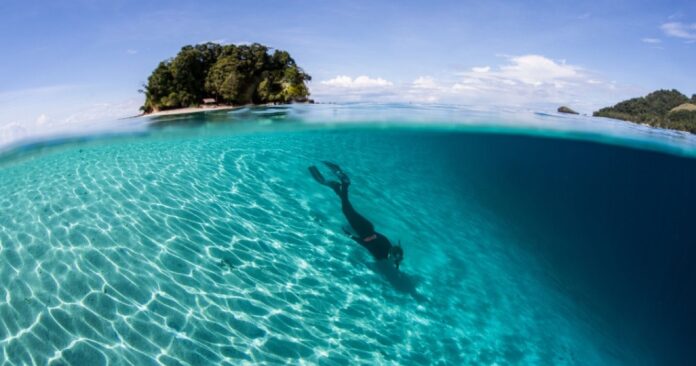‘Eat, Sleep, Dive, Repeat!’ – if that’s the motto, you’re in for a treat; liveaboard vacations are the one and only way to get that done in that exact order. More than just any old dive holiday, a liveaboard trip delivers a fully immersive underwater and topside experience and allows divers to explore some of the best sites in the world – and a lot of them – over a short period of time. Ranging from a few days to a couple of weeks, a liveaboard safari also provides the ultimate opportunity to the most discerning underwater enthusiasts: access to remote sites that land-based dive operators simply don’t have the resources, time, and facilities to reach.
With so many epic sub-sea realms to discover all across the vastness of the globe’s oceans, scuba divers are truly spoiled for choice when it’s time to pick their next adventure. There are so many formidable liveaboard destinations to choose from, each with its own unique dive sites, marine species, sea conditions, and above-water experiences. So, to help liveaboard lovers decide where to go for their next “eat, sleep, dive, repeat” exploration of the planet’s most celebrated subaquatic seas, this guide explores the very best liveaboard locations and dives into the details of each unique place.
11 The Solomon Islands
It’s difficult to get more remote than the Solomon Islands; situated around 1,000 miles east of Papua New Guinea, trips usually depart from Honiara and head to these isolated coral atolls, and there are only limited operators and trips available. Highly sought-after, these islands can be hard to get a booking for – and one breath underwater answers why. Completely untouched and unspoiled thanks to scarce tourism and fishing, the dive sites here are rich and rife with life and open up an exclusive opportunity to dive some of the world’s most pristine reefs – of which there are seemingly more than anywhere else in this spectacular part of the world.
And it’s not just vibrant hard and soft coral-laden reefs and gigantic gorgonian sea fans pulsating with equally vibrant tropical fish that makes this spot so sublime (not to mention the big pelagics such as dolphins, mantas, and whales at many sites), it’s also the variety of dive sites. From caves and canyons to WWII wrecks and mind-boggling muck diving sites prime for rare critter hunting, the diversity of diving in the Solomon Islands is celebratory. Still vastly under-explored, most of the 900-odd islands here can’t be visited on a single trip, and many boats don’t even go to some of them due to their remoteness. Generally speaking though, most liveaboard trips to these islands are anywhere from seven to 14 nights and do cover a decent amount of ocean to give a superb sample of what this sensational speck in the sea has to offer – which is indeed some of the very best underwater action and marine life in the Indo-Pacific.
10 The Cayman Islands
Nestled in the northern Caribbean Sea, the Cayman Islands offer diverse diving styles to suit all experience levels. Grand Cayman at the farthest west is the islands’ largest, while Little Cayman and Cayman Brac are found slightly north and around 75 miles to its east. Because of the slightly lengthy yet doable distance between these islands, exploring their dive sites by liveaboard is undoubtedly the best way to see the best of each in one trip. Most liveaboards start and end in George Town, Grand Cayman, moving east on a path that showcases each iconic dive site along the way, many of which deliver some impressive underwater topography, including sandy lagoons, dramatic wall dives, and towering reefs that give way to plummeting drop-offs.
What’s more, the marine life in this part of the Caribbean is among the most mind-blowing, featuring healthy corals, massive sponges, healthy reef fish numbers, and of course, a great number of macro critters to hunt for. The big stuff also thrives in these waters, with appearances from huge groupers, barracuda, various rays, turtles, and even majestic nurse sharks at many dive sites. Specific sites worthy of one’s attention in and around the Cayman Islands that liveaboards visit include Stingray City and the SS Kittiwake Wreck, the latter being one of the most accessible shipwrecks in the Caribbean. Cayman Brac also has its own shipwreck to dive; the MV Captain Keith Tibbetts, which is another popular site frequented by liveaboard boats.
9 Tubbataha, Philippines
The Tubbataha Reefs Natural Park is a UNESCO World Heritage Site and one of the best diving areas in the Philippines – and due to its remoteness, it’s only accessible via liveaboard. Located in the Palawan region, Tubbataha is home to untouched reefs and prolific amounts of tropical fish and even offers excellent encounters with pelagic life. In fact, the reefs here are so rich and diverse that almost 50% of the planet’s coral species inhabit them, which provide homes for over 600 fish species and around a dozen kinds of sharks.
From white tip reef sharks, tiger sharks and manta rays to turtles, schooling barracuda and jacks, and rare macro creatures like seahorses, nudibranchs and ornate ghost pipefish, divers who explore Tubbataha’s pristine waters can expect to encounter all manners of fascinating creatures. And with such incredible underwater diversity, the liveaboard journey is more than worth the 10 hours it takes to get there from Puerto Princesa – the place where the majority of liveaboard boats depart from and return to. Also, divers should note that trips to this impeccable marine park only run between March and June each year, and they do book up quite quickly, so it’s better to reserve well in advance to avoid disappointment.
8 Belize
Heading to the western shore of the Caribbean Sea will see travelers arrive at Belize – one of the region’s lesser crowded scuba diving destinations with a wealth of pristine, uncrowded underwater sites to match. Diving in Belize is incredibly varied, with many of the sites being beautiful fringing reefs that are protected in the Belize Barrier Reef Reserve System. Commonly described as one of the most stunning, unspoiled underwater ecosystems in the entire Western Hemisphere, it’s no wonder Belize and its glorious reefs are some of the most breathtaking on Earth – and the best way to marvel at them is by liveaboard trip.
Since many of Belize’s dive sites are spread out along its expansive coastline, a liveaboard is definitely the most convenient way to discover as many of them as possible. Many dive resorts and dive operators do visit a lot of sites, but liveaboards enable access to far more of them than land-based operators. Typically, liveaboard vessels both set sail from and finish in Belize City and usually spend most of the journey at the outlying sites of Lighthouse Reef, Half Moon, and Turneffe Reef, to name but a few extraordinary dive areas.
It’s at these sites, as well as at many of Belize’s others, where sub-sea explorers can enjoy a mesmerizing abundance of kaleidoscopic coral gardens, big sponges, and intense amounts of tropical fish species, gliding rays, and no lack of prowling reef sharks. Really lucky divers who visit at the right time may even get the chance to encounter the biggest fish in the sea – the humongous whale shark – which is occasionally seen around the full moon period in April and May. And, to save the very best ’til last, Belize has one more surprise up its sleeve – one that most other dive destinations around the world can beat: the Great Blue Hole. Globally famed and a diver’s hotspot, this UNESCO World Heritage Site measures 300 meters (984 feet) across and descends to 108 meters (354 feet), and is thus the third-deepest blue hole on the planet just behind Dean’s Blue Hole in the Bahamas and Dragon Hole in the South China Sea. Minimal marine life there may be at Belize’s massive blue hole, but what it lacks in critters it makes up for with its surreal subaquatic terrain; think stupendous rock formations, stunning stalactites, and of course, the mesmeric depths of the dark hole itself.
7 The Maldives
The Maldives offers a lot to divers of all budgets, skills, and preferences. A welcoming mix of affordable liveaboard options and high-class luxury vessels, this heavenly nation of atolls located in the Indian Ocean is one of the best liveaboard destinations that equally suits beginners, the advanced, the budget-conscious, and those plush with cash. Most liveaboards depart from and return to the capital, Malé, but there are several one-way trips available as well at certain times of the year.
As for the diving, it’s truly exceptional; with crystal clear visibility, healthy hard and soft corals of all colors, intense amounts of tropical fish, and plenty of reef sharks and eagle rays, the atolls’ teeming reefs are nothing short of magical. In addition, divers with a little more experience will be in their element at the atolls’ outer reefs and pinnacles, where currents bring in manta rays, whale sharks, and other large pelagic species who arrive in their droves to feed.
In terms of where to dive, though, many divers claim that the Maldives’ best sites are in the Deep South parts, which doesn’t really narrow it down that much since it covers such a vast area. Naturally, it’s not possible to visit every top site on a single trip, which makes for a great excuse to come back to dive another round. However, on the whole, divers in search of this atoll nation’s best samples of its underwater world can’t go wrong with a liveaboard trip to Ari Atoll and Malé Atoll in the country’s central islands, which are major pelagic hotspots.
6 Fiji
Remote and remarkable Fiji boasts around 330 islands and about 500 or so islets, which means one sure-fire thing: the ultimate way to explore them is by liveaboard boat. Fiji is a popular resort holiday destination with plenty of dive operators and centers on land. But visitors who want to discover as much of Fiji’s underwater world as they can possibly fit in on one trip will be far better served by the liveaboard option. In fact, Fiji is one of the world’s greatest liveaboard hotspots and its fame is only growing as more and more of its sublime dive sites are discovered. Most liveaboard vessels depart from Lautoka, taking divers to some of the top sites in the soft coral capital of the world. Only those who have savored the liveaboard diving experience in Fiji can tell of the unbelievable colors and vibrancy of the region’s healthy soft corals and bustling reefs, which can put others around the globe to shame.
And the marine species residing in Fiji’s waters are just as magnificent, with rainbow-hued spectacles put on by vibrant tropical fish of all sizes. Akin to an aquarium out in the wild, divers fortunate enough to explore Fiji’s subaquatic alien planet of bursting colors can swim alongside tons of species, such as anemonefish, angelfish, turtles, and moray eels that thrive on the reefs, while tuna, sardines, and barracuda lurk above. If it’s bigger critters divers are after, then there are some sites where encounters are possible, with one of the most famous being Beqa Lagoon’s shark dive – an experience wherein divers get the exclusive chance to spot up to eight individual species of shark, with two of the rarest (but possible) being bull sharks and tiger sharks.
5 Socorro Islands, Mexico
The Socorro Islands are uninhabited, remote, and beautiful – so much so that they are an established UNESCO World Heritage Site. Situated around 240 miles from Cabo San Lucas on the Baja California Peninsula, these windy islands are the home of a plethora of epic pelagic species along with an impressive number of sharks. As such, they’re a top liveaboard destination for folks who can’t resist diving with the big stuff. Although the Socorro Islands are fairly out of the way, that doesn’t mean they’re difficult to get to; these islands are one of Planet Earth’s most accessible dive areas for encountering the big boys, and they are especially easy to reach from North America.
Overall, divers who hop on a liveaboard trip to the Socorros can relish one of the best shark diving experiences in the world, with impressive numbers of diverse sharky species inhabiting and passing through their waters, including oceanic whitetips, silky sharks, resident Galapagos sharks, and even schooling hammerheads who frequently put on a show around the islands’ sub-sea rocky pinnacles, plunging walls, and steeply sloping reefs.
Even with all the shark action here, it’s the prolific manta ray encounters that are the islands’ most noteworthy experiences, particularly at famous sites like The Boiler – a manta ray cleaning station where seemingly dozens of these majestic gentle giants come to be cleaned of dirt and parasites by hungry cleaner fish. Plus, plenty of other large fish can be seen in and around the Soroccos, like marlin, tuna, and also pods of curious dolphins, the latter of who are said to be rather playful with divers at times. Thought the shark fest couldn’t get any more awesome? Then get this: come the winter months, the Socorro Islands are excellent for spotting whale sharks.
4 The Galápagos Islands, Ecuador
The world-renowned Galápagos Islands are internationally celebrated for their abundance of rare, native, and even endangered creatures that are as fascinating to observe as they are gorgeous. A place of extreme biodiversity, it’s not just the attention of Charles Darwin that this volcanic archipelago garnered; it’s also discerning divers’. This entire UNESCO World Heritage Site around 560 miles off the west coast of Ecuador enjoys a unique position in the eastern Pacific Ocean, one that attracts the ocean’s underwater giants to its region. Although one can explore the Galápagos Islands’ marine realms from the shore, the very best experiences and dive sites are only for those who explore them via liveaboard. Much of the islands’ top sites, such as the Northern Wolf and Darwin Islands, are limited to liveaboard access, of which there is no lack, thankfully; numerous boats set sail from San Cristobal, Port of Seymour, and Baltra, and all follow a very specific, pre-organized itinerary permitted by the government for the purpose being that the islands and their inhabitants remain protected and preserved.
Ultimately, the Galápagos Islands are a magnet for choosy divers who want to scope out their extraordinary endemic species, which have evolved away from mainland Ecuador in this remote part of the world. The archipelago boasts hefty amounts of pelagic species, many that reside in its waters and numbers that merely pass through. From massive shoals of jacks and schooling fish to dolphins, mola mola, turtles, and sea lions, the species to be seen beneath the waves of these islands tick all the boxes of divers’ “must-see” list. Plus, what one can see here can change throughout the seasons; for example, divers have a good chance of spotting whale sharks in the months between June and November, meanwhile, mantas might be seen from December until May.
In addition, these islands are also a fantastic shark destination, and the amazing rocks of Wolf and Darwin Islands are home to some of the world’s biggest scalloped hammerhead schools. Even more amazingly, most liveaboard operators in this region will offer land excursions as part of the trip in between diving, allowing guests encounters with a variety of topside Galápagos animals, such as Galápagos fur seals who often laze on the beaches, iguanas, and many more creatures and flourishing Galápagos flora and fauna.
3 Raja Ampat, Indonesia
Situated right in the beating heart of the Indo-Pacific Coral Triangle, this chain of off-the-radar islands is the home of one of the oceans’ richest marine biodiversities, earning it international celebrity among the planet’s pickiest divers. Boasting what seems to be hundreds upon hundreds of reefs, with more dive sites being discovered every year as the exploration of its vastness continues, Raja Ampat is the place to go if sampling the Coral Triangle’s diverse offerings is on the bucket list. The most popular itinerary consists of a round trip, which departs from and returns to Sorong. However, many other liveaboard boats leave and disembark at several other spots, such as Ambon, Kaimana, Bitung, Waisai, and many more.
The various route options and a huge number of superb dive sites mean that there are so many itineraries possible, exposing divers to tons of areas and diverse spots that allow them to return time and time again to explore different routes. Along all these routes, divers can visit Raja Ampat’s most popular sites, as well as those less explored and well-known. No matter where they dive though, what’s certain is that the marine kingdom is prolific, with no shortage of colorful corals of all shapes and sizes, varied underwater topography, immense amounts of tropical fish, turtles, rare macro critters, and best of all: year-round reef and oceanic manta ray sightings. One more point that makes this picturesque place a pure paradise is its stunning scenery and surroundings above the surface; sublime tropical beaches, lush foliage, and forests, and dramatic landscapes all form a picture-perfect paradisiac postcard.
2 Komodo, Indonesia
Komodo is world-famous for its macro diving and energetic drift dives along its cinematic reefs, particularly along the island’s south coast. Officially designated as the Komodo National Park and remains under strict protection, the island boasts a huge amount of coral-covered walls and towering underwater pinnacles that attract schooling fish. Whilst it is possible to explore Komodo’s best dive sites with land-based operators, opting for a liveaboard instead cuts out the lengthy hour or two journeys there and back every day.
What also makes this aquatic environment so species-rich is the water; full of nutrients, the water attracts hordes of plankton, which can impact visibility at specific times of the year, but in turn draws in and supports a wide array of marine creatures who feed on said plankton – massive filter feeders such as manta rays for one, which divers can see year-round at Komodo’s shallow dive sites to its south, with one of the most renowned being Manta Alley. Also, it’s thought that over 250 coral species and over 70 unique kinds of sponge thrive in Komodo’s waters, which collectively create mesmeric displays of color on the reefs, as well as shelter an abundance of reef-dwellers – even the rarer, sought-after critters like stargazers, frogfish, and unusual nudibranch.
1 Cocos Island, Costa Rica
As another “big marine animal” destination, Cocos Island is a favorite liveaboard site attracting divers who want encounters with sharks. The waters are rich in nutrients, which draw in myriads of hungry pelagics that descend to feed along the rugged, rocky coast of this remote outcrop located 340 miles southwest of the Costa Rican mainland. Scuba divers who book their dream trip to Cocos will not be disappointed, and it’s all down to this reason: hammerhead sharks. This magnificent UNESCO World Heritage Site is easily home to hundreds of hammerheads, who hover effortlessly in the strong currents, allowing divers to watch their almost still-like display in the water.
And it’s not solely hammerheads that steal the show here, for there are others that thrive in these waters too (especially at dusk when they put on a wild feeding frenzy show), like silky sharks, silver tips, white tip reef sharks, and the beloved Galápagos shark. Furthermore, folks who get sick of sharks will be glad to know there are other creatures to look out for as well, including tuna, wahoo, jack, dolphins, and even manta rays and whale sharks. Plus, even a number of endemic fish can be spotted here, such as the rare red-lipped batfish to name just one that divers should keep an eye out for. Throw in the possibility of land tours through the island’s luscious tropical rainforest, and liveaboard lovers are in for the time of their lives.
Become A Dive Pro: The World’s Best Places To Get Your Divemaster Certification
Read Next
About The Author
Lauren Feather
(138 Articles Published)
Lauren is a scuba diving instructor and award-winning underwater photographer originally from the United Kingdom. Having spent the last decade traveling and working around the world managing dive centers in Japan, the Philippines, Thailand and France, she enjoys sharing her passion for the underwater world with others. Before her adventures, Lauren attained her degree in Japanese and French languages at the University of Hull, which has served her well in the world of travel, diving and tourism. Whilst her day job involves training people to scuba dive, by night, she indulges in various projects such as writing, translating, and working as a volunteer for an international dog rescue organization. When she’s not busy with any of these things, she’s walking her dogs, sipping coconut water on the beach, indulging in anime and manga, or rocking out to her hefty heavy metal collection.
More From Lauren Feather










